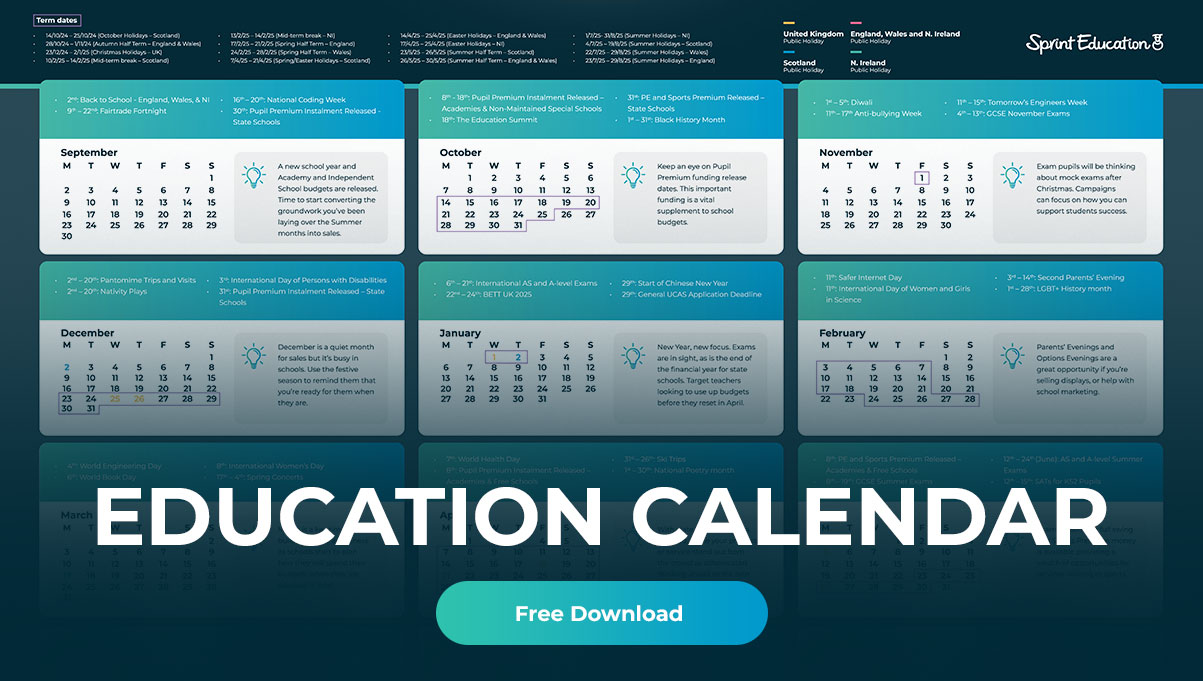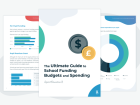The Ultimate Guide to School Funding Budgets and Spending
The Ultimate Guide to School Funding Budgets and Spending
Give your marketing activities an edge by understanding how school funding works, how much money they have, and when and where to target your spend.
Give your marketing activities an edge by understanding how school funding works, how much money they have, and when and where to target your spend.
The big picture – overall education budget
Between 2019 and 2020, the UK spent approximately £92.3 billion on education overall.
£46.5 billion of that total was spent on secondary education, and £31.6 billion on primary and early years education.
Core school funding is set to increase over the next three years as part of the government’s commitment to introduce ‘the largest cash increase for schools in a decade’.
Overall education budget 2019-2020 – £92.3bn
School Budgets - the basics
Core schools funding is distributed to local authorities through the Dedicated Schools Grant (DSG). Local authorities then allocate budgets for individual schools within their authority.
The National Funding Formula
The National Funding Formula (NFF) was first introduced in December 2017, and all local authorities will be expected to have transitioned to the formula by the end of the ‘transition phase’ in September 2021.
However, the government has acknowledged that flexibility is needed due to the challenges of the ongoing pandemic.
The formula aims to ensure all school budgets are set using the same criteria. The DfE believes that this will direct resources where they are most needed. It doesn’t mean that all schools receive the same budget. There are a range of different factors taken into account when calculating schools’ budgets.
- Basic entitlement: Based on the number of pupils and a per-pupil rate.
- Deprivation: Based on factors such as free school meals allocation.
- Per-pupil funding: Every school attracts a set funding amount per pupil.
- Low prior attainment: Optional additional funding for schools with pupils not achieving expected standards.
- Looked after children (LAC): Based on the number of children in local authority care.
- English as an additional language (EAL): Based on the number of EAL pupils.
- Pupil mobility: Schools with a high proportion of pupils joining on a non- standard start date will have a lower mobility.
- Sparsity: Additional funding for schools that are unable to share resources due to them being small or isolated.
- Lump sum: A fixed and equal lump sum (this can be different for Primary and Secondary), decided upon by local authorities.
- London fringe: Applicable only to Buckinghamshire, Essex, Hertfordshire, Kent, and West Sussex.
- Split sites: Support for schools that have unavoidable extra costs due to split sites.
- Rates: Premises funding allocated based on varying local rates, such as energy.
- PFI contracts: Support for schools with PFI contracts.
- Exceptional circumstances: Factors relating to school premises, including listed buildings, hire of PE facilities, and more.
Per Pupil Funding
Each school receives a minimum funding guarantee to protect them against significant changes in per-pupil funding.
Pupil premium Grant Although the main aim of the pupil premium is to raise attainment, schools have some flexibility in how they spend the money. They are entitled to spend it on non-academic outcomes, such as improving pupils’ mental health, boosting attendance, and providing activities that will also benefit non-eligible pupils.
Schools get pupil premium grants based on the number of pupils they have in January each year from the following disadvantaged groups:
- Primary School pupils who qualify for free school meals.
- Secondary School pupils who qualify for free school meals.
- Looked after children (LAC) in the care of a Local Authority.
- Children who have left the care of the Local Authority because of adoption or guardianship arrangements.
Pupil premium grants are released in quarterly instalments throughout the financial year.
Our Education Insights Calendar will take the guessing out of your marketing to schools altogether. It’s the most detailed education calendar available for sellers to schools with events, deadlines, exams, awareness days, and holidays across 12 categories – all in one place. If the Education Insights Calendar sounds like the tool you need to take your marketing to schools to the next level, but you’re not yet a Campus user, get in touch with us for a quick chat and a no- obligation quote.
Free School Meals
Pupils living in households on income-related benefits (such as universal credit) are eligible to apply for free school meals. In England, Scotland, and Wales pupils receive free school meals as long as their annual household income does not exceed £7,400 after-tax and not including welfare payments. In Northern Ireland, the cap is set at £14,000 a year.
If a child is eligible, their parent or guardian can apply and claim free school meals at any age. In England and Scotland, all state school pupils in Reception, Y1, and Y2 can get free school meals during term time, regardless of their household income. Schools encourage parents who are eligible to apply to gain access to pupil premium.
PE and Sport Premium
The PE and sport premium provides ring-fenced money to primary school Head Teachers to improve the quality of the PE and sports activities they offer their pupils. Schools receive PE and sport premium funding based on the number of pupils in years 1 to 6. They can only spend this money on developing or adding to the physical education activities, and sports that they provide.
In cases where schools do not follow year groups (for example, in some special schools), pupils aged five to ten attract the funding.
Schools with 16 or fewer eligible pupils: £1,000 per pupil (2020-2021) Schools with 17 or more eligible pupils: £16,000 and an additional £10 per pupil
PE and sport premium funding is released in two separate payments in a year. Below are dates for the 2020-2021 period, provided as an example.
Local authorities receive funding for maintained schools: 30 October 2020, 30 April 2021
Local authorities receive funding for new maintained schools or those teaching eligible pupils for the first time in 2020 to 2021 academic year: 26 February 2021, 30 April 2021
Academies and free schools: 2 November 2020, 4 May 2021
New academies and free schools teaching eligible pupils for the first time in 2020 to 2021 academic year: 1 March 2021, 4 May 2021
Non-maintained special schools: 2 November 2020, 4 May 2021
Services Premium
Schools get £310 for every pupil with a parent or carer who is serving in HM Forces or has retired on a pension from the Ministry of Defence. The funding is to help with pastoral support.
Condition Improvement Fund CIF
The Condition Improvement Fund is available for eligible academies, sixth-form colleges, and voluntary-aided schools to apply for. The priority for the fund is to ensure buildings and facilities are kept safe and in good working order. Eligible schools must apply for the annual capital funding with proof of good financial management.
CIF Registration Deadline: Monday November 29th 2021 CIF Application Deadline: Monday December 13th 2021 CIF Notification of Outcomes: Throughout March 2022
Coronavirus Catch-up premium – 2020-21
To help schools reverse the impact of lost teaching during the pandemic and support pupils, the government has pledged £1bn in additional funding for specific catch-up activities.
Mainstream schools will get £80 for each pupil in reception to year 11 inclusive. Special and alternative provision schools will get £240 for each place for the 2020-21 academic year.
• £650 million will be split between schools in the academic year. School leaders will be able to decide how their funding is spent. • £350m - National Tutoring Programme – additional, targeted support for pupils most in need.
Mass asymptomatic testing: schools and colleges
At the end of December 2020, the government published guidance for Secondary Schools and Colleges on coordinating rapid testing to prevent school closures. Alongside the guidance, the government allocated £78 million in funding to support all secondary schools and colleges with testing costs incurred, to be distributed to schools based on size.
Other income sources:
Creating additional sources of income is becoming increasingly common for schools.
Facilities Renting out facilities out of school hours, such as sports facilities, halls for community group use, and even the whole school for summer holiday provision, is increasingly common.
Catering Schools who prioritise making their own food and have suitable facilities are often able to create additional income from this.
Fundraising/Donations Schools are entitled to ask for financial support through voluntary donations or by fundraising activities often organised by PTAs (parent-teacher association). Schools will regularly fundraise for charities. Fundraising can be whole-school led or often led by departments or individuals. Guy, one of our Co-Founders, often had to host school concerts to raise funds for his department as Head of Music at a Secondary School.
Voluntary contributions Schools have always been allowed to ask parents for voluntary contributions towards certain ‘optional extras’, such as school trips. However, legally, local authorities and governing bodies of state-maintained schools and academies cannot charge for education that takes place in school hours. In recent years, schools have increasingly asked for voluntary contributions towards essential running costs as schools struggled with austerity budgets.
Schools’ top 4 spending priorities, across all school types:
-
Teaching staff: Including supply staff and other staff costs.
-
Back office: Administrative supplies and costs.
-
Premises: Buildings, maintenance, cleaning, and caretaking.
-
Learning resources: All costs related to physical and digital learning resources.
You can access a huge variety of data, including school financial data, via Campus to help segment and target your marketing activities more effectively. If you’re not yet a Campus user – get in touch with us for a quick chat and a no-obligation quote.
But wait, there’s more!
The last year has been anything but ‘business as usual’ for schools. While the results above give us a good overview of schools’ general spending priorities over the last few years, we wanted to find out what impact the ongoing pandemic had on spending in 2020.
We conducted a survey at the end of 2020 to hear directly from teachers and school staff on our database. 2648 people answered our question regarding the areas their school increased spending during 2020, revealing some interesting shifts in priority.
In which area did your school increase it’s spending during 2020? 2648 out of 2648 people answered this question (with multiple choice)

We can see that Technology has jumped to the top of the priority list when we ask teachers directly what their schools’ priorities are, with a massive 40.2% telling us that their school increased spending on Technology during the year.
This is unsurprising, as schools spent a large period of 2020 working remotely, and many predicted (now proven correctly) that schools may return to remote learning in 2021 after the Christmas holidays.
According to estimates from Ofcom, between 1.14 million and 1.78 million children in the UK do not have home access to a laptop, desktop, or tablet.
Whilst the government committed to providing another 440,000 laptops for schools to aid remote learning in December 2020 – taking the number of laptops bought by the government to over one million and pushing the cost of the scheme up to £300 million – the government is still facing criticism that the rollout of school laptops is taking too long, supply is not sufficient, and schools are having to fill in the gaps using their budget.
Online Learning/Tutoring is another predictable priority for schools.
This is also an area that looks set to grow in 2021, following the new remote learning expectations published by the DfE in January 2021.
The DfE guidance states that provision should include both recorded or live direct teaching time and time for pupils to complete tasks and assignments independently. Interestingly, the guidance was specific in noting that online video lessons used in teaching do not necessarily need to be recorded by teaching staff at the school – presenting huge opportunities for businesses who are experts in remote learning delivery and have video lessons, aligned to the curriculum, that are ready to go.
In which area did your school decrease it’s spending during 2020? 2648 out of 2648 people answered this question (with multiple choice)

Interestingly, 24.6% of respondents reported a decrease in spending on supply teachers during 2020 and 19.8% said they had increased spending on supply teachers.
The obvious contrast in results here is likely to be due to the split in 2020 of remote learning during the first half of the year and in-school learning during towards the latter end of the year. Supply teachers were unlikely to be as in-demand during remote learning periods (although we know that many teachers were still in school providing for keyworker children). Once classrooms reopened to all after the summer holidays, there were many reports of teachers struggling to get tested throughout September for COVID-19 and therefore having to rely on supply teachers or teaching their class from home even though their students were in their classroom.
17.3% of respondents say that they decreased spending on Outdoor learning during 2020 and just 4.2% said they increased spending in this area, making this, sadly, one of the biggest losers from these results.
This survey was conducted during the winter period which may have had some bearing on the results, as the last few months of spending (during winter weather) may have been at the forefront our survey respondents minds. It will be interesting to see if schools begin incorporating more outdoor learning into their curriculum as we move towards summer 2021 and lockdown restrictions are gradually lifted.
The starkest result from the two survey questions is the prioritisation of Safeguarding measures, with just 0.05% saying they had decreased spending (the lowest reported decrease) and 22.1% reporting an increase in spending during 2020. With increased social isolation and added employment and financial pressures of the pandemic being felt by many families across the country, various charities have reported a concerning rise in domestic child abuse and clearly, schools have responded to this.
school budgets – meet the key decision-makers
CEO - Decision-Maker A CEO is the strategic lead of a Multi-Academy Trust, supervising all Head Teachers working within the trust. They take full responsibility of all non-education outcomes, specifically the academies’ finances and budgets, and the operational growth of the trust.
Head Teacher / Principal - Decision-Maker The most senior teacher and leader of the school, the Head Teacher is responsible for pupils’ education, staff management, and policymaking. They will typically work with governing bodies to communicate school values; support the Bursar in controlling school finances in line with funding regulations; and set, track, and monitor individual and whole-school targets and performance.
Bursar / Business Manager - Decision-Maker Reporting directly to the Head Teacher and potentially communicating with local authorities and school governors, the Bursar is in charge of the school’s financial administration. The Bursar manages the school budget and is responsible for the procurement and payment of products and services. They may perform additional duties, including recruitment, marketing, and holding managerial responsibility of other administrative staff.
Governor - Decision-Maker Governors are voluntary members of the community who want to contribute to the school’s strategic direction. Through setting aims, objectives, policies, and targets, they typically ensure that the school’s budget is well-spent, and challenge and support the Head Teacher’s delivery of academic outcomes.
Trustee - Decision-Maker Governors within an academy trust are known as trustees, as opposed to Governors who belong to faith schools or schools run by the Local Authority. Trustees perform the same actions as Governors, although work more closely with the trust’s CEO and answer to the trust’s members.
For our full Who’s Who Guide to UK School Staff, click here.
When do they plan their budgets and make purchases?
Maintained schools run their budgets in line with the local authority financial year of April to March. In contrast, Academies run them in line with the school year, from September to August.
April: State School Budget Released September: Academies Budget Released
Most schools will begin forecasting next year’s budget between January and March while reviewing their current budget to identify any areas for improvement or any underspend.
It’s important that schools don’t have large surpluses at the end of the year because local authorities can claw these back. Academies, on the other hand, are allowed to retain unspent funds as optional reserves.
Schools will be keen to use up any surplus budget before the end of the financial year to avoid losing it.
Schools plan their budgets with their school improvement plan (SIP) in mind. This is to ensure that they are planning for the future and that all resources purchased are sustainable and are in line with the long-term goal of improving the educational outcomes of students.
Schools are encouraged to benchmark when procuring resources. The DfE launched a benchmarking system to help schools easily see how much neighbouring schools spend on resources, and connect with other schools to purchase resources or services together.
The benchmarking process is designed to help schools quickly form a business case to put forward to Governors or the SLT for any proposed changes that they believe will improve student outcomes.
What Next?
There you have it – the ultimate guide to school budgets, funding, and spending. Now it’s time to put these insights to good use!
Ready to discuss how you can many accurate, continually updated teacher emails you can reach with your next campaign?
Get in touch on info@sprint-education.co.uk or 01684 297373 for a quick count and a walkthrough of Campus.
Tags
Education Budget
How to Sell to Schools
School Budgets
Selling to Schools
Similar Articles


Selling to Schools in the Autumn Term
Start this September with a standout strategy set to make this academic year your most successful yet.


Summer School for Edu-Marketers: Top Reads & Insights
Prepare yourself for September with our essential reports, blogs and videos designed to quench your edu-marketing thirst.


Expert marketing to schools support and solutions
Expert marketing to schools solutions
Email Head Teachers, Teachers, and Staff Inboxes
Email teachers and staff inboxes
Sell More to UK and Global Schools and Colleges
Sell more to schools and colleges

































